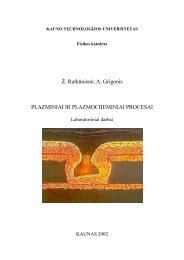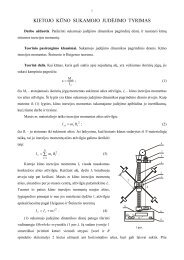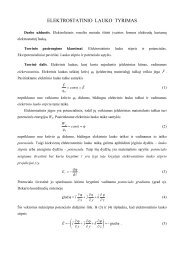PROCEEDINGS OF THE 7 INTERNATIONAL ... - Fizika
PROCEEDINGS OF THE 7 INTERNATIONAL ... - Fizika
PROCEEDINGS OF THE 7 INTERNATIONAL ... - Fizika
Create successful ePaper yourself
Turn your PDF publications into a flip-book with our unique Google optimized e-Paper software.
MEDICAL PHYSICS IN <strong>THE</strong> BALTIC STATES 7 (2009)<br />
Proceedings of the International Conference “Medical Physics 2009”<br />
9 - 10 October 2009, Kaunas, Lithuania<br />
OSL IN HOUSEHOLD SALT (NaCl) FOR ENVIRONMENTAL, OCCUPATIONAL<br />
AND MEDICAL DOSIMETRY<br />
Christian BERNHARDSSON*, Maria CHRISTIANSSON*, Christopher RÄÄF*, Sören MATTSSON*,<br />
*Medical Radiation Physics, Department of Clinical Sciences, Malmö, Lund University, Malmö University Hospital,<br />
SE-205 02, Malmö, Sweden<br />
Abstract: The recent progress in our work to implement salt (NaCl) as a dosemeter is presented. Laboratory<br />
investigations have indicated a linear dose response from 1 mGy to about 100 mGy and detection limits down to 0.1<br />
mGy. Investigations in the clinic comparing TL-dosimetry in LiF and OSL in NaCl have indicated a similar dose<br />
response for the two dosemeters at different photon energies. Field studies with stationary dosemeter kits containing<br />
TLDs (LiF) and NaCl suggests that salt is also a good candidate for environmental monitoring of radiation.<br />
Keywords: OSLD, TLD, NaCl, LiF, dosimetry<br />
1. Introduction<br />
Today there are no direct dosemeter for the general<br />
public in case of an accident involving external<br />
exposure from ionising radiation. There are however<br />
methods for assessing collective, and to some extent<br />
also individual, doses in such cases [1, 2]. The<br />
drawback with many of the retrospective methods for<br />
individual dose estimations is that they are complicated<br />
and have a relatively high dose threshold under which<br />
they are unreliable. In our search of finding methods<br />
and materials for individual dose assessments we have<br />
focused on optically stimulated luminescence (OSL) in<br />
household salt (NaCl). This particular dosemeter can be<br />
found almost everywhere and it has shown several<br />
promising dosemetric properties [3, 4] and e.g. a linear<br />
dose response between 0.1 mGy to 100 mGy and a low<br />
limit of detection, down to 0.1 mGy for some brands of<br />
salt [5].<br />
The use of OSL in NaCl is not limited to retrospective<br />
dosimetry. Preliminary investigations carried out in<br />
different radiation environments in a hospital, shows a<br />
similar response for LiF and NaCl for absorbed dose<br />
measurements at different photon energies. NaCl<br />
dosemeters can also be used as a cheap alternative for<br />
environmental dosimetry. Studies that have been carried<br />
out in a highly 137 Cs-contaminated village in Belarus<br />
during the summer of 2008, suggests that NaCl<br />
dosemeters are as good indicators of absorbed dose and<br />
its variation, as the particular LiF (TLD-100)<br />
dosemeters used in the same village.<br />
65<br />
2. Material and methods<br />
To investigate salt as a dosemeter in different radiation<br />
situations, special dosemeter kits have been designed<br />
containing NaCl and LiF. These “twin” dosemeter kits<br />
were normally assembled with two sections of 30-50 mg<br />
NaCl and two chips of LiF (TLD-100, Harshaw). Before<br />
the dosemeter kits were assembled, which was carried<br />
out the night before the distribution, the salt was<br />
exposed to sunlight (bleached) for a few days, in order<br />
to get a low background luminescence. The chips and<br />
the salt were placed between two 4 mm thick layers of<br />
PMMA, this forming a dosemeter kit of two different<br />
luminescent materials. To avoid bleaching of the OSL<br />
signal, all dosemeter kits were covered with a light tight<br />
adhesive tape. Additionally, the environmental<br />
dosemeters were placed in plastic bags filled with silica<br />
gel, to protect the dosemeters from rain and moist<br />
during the measurement period.<br />
After the kits were collected, the TLDs were read out<br />
using a TOLEDO TLD reader (VINTEN Instruments,<br />
England). The signal in the NaCl dosemeters was<br />
assessed using a TL/OSL reader (TL/OSL DA 15; Risø<br />
National Laboratory, Roskilde, Denmark) which is an<br />
automated equipment that can manage 48 samples (or<br />
aliquots) per run. The salt from each dosemeter kit was<br />
carefully mixed and divided onto five, or more, different<br />
aliquots. To assess the stored signal in the salt, it was<br />
optically stimulated by blue light (λ = 470±30 nm) for<br />
40 – 100 s. The average signal, OSLsignal (counts mg -1 ),<br />
for a dosemeter kit was defined as:








